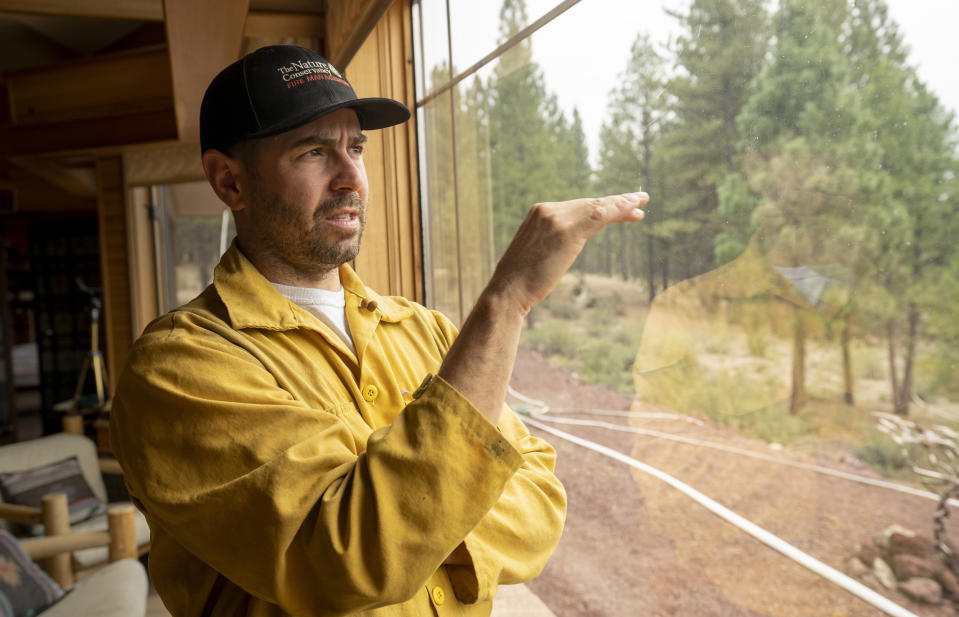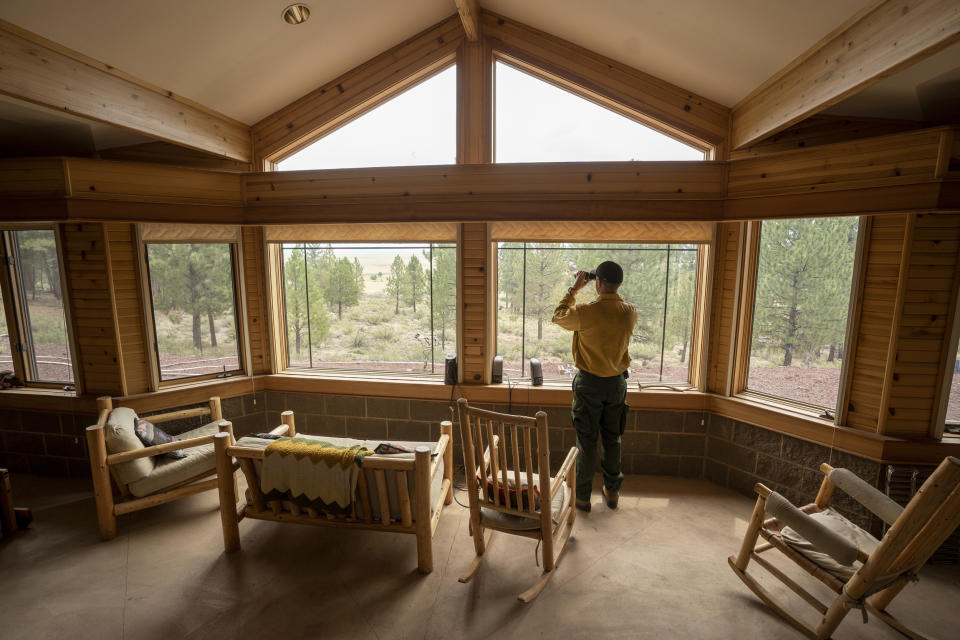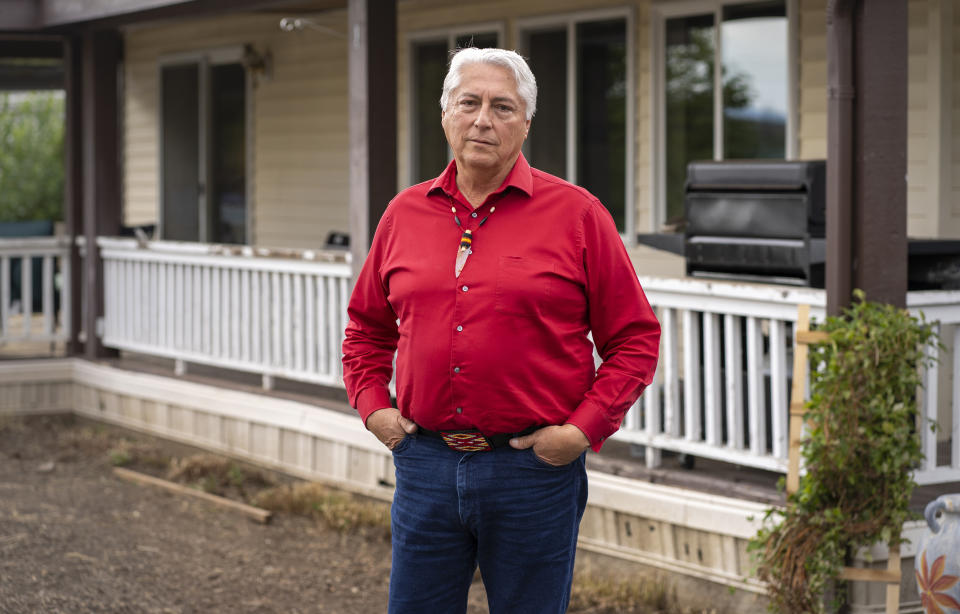What a recently burned tract of land in Oregon can teach us about fighting wildfires
- Oops!Something went wrong.Please try again later.
KLAMATH FALLS, Ore. — It was around 4 p.m. in mid-July when ecologist Pete Caligiuri saw 150-foot flames from the Bootleg Fire pour over a nearby ridge and creep closer to a facility where researchers have been studying wildfire behavior and mitigation techniques.
"The flames were well above the biggest trees," said Caligiuri, the Oregon forest program director for the Nature Conservancy, which runs research at the Sycan Marsh Preserve in Fremont-Winema National Forest.

The facility has served as home base for researchers who spent the last decade thinning young trees and using controlled burns to restore giant ponderosa pines to a more fire-resistant state.
By combining modern wildfire science with traditional tribal knowledge of the Klamath people, the researchers seek to understand whether returning forests to their original condition, including allowing them to burn at low intensity every few years, can ultimately help make wildfires less devastating to the ecology and neighboring communities.
The question is paramount as 107 large wildfires were consuming more than 2.1 million acres across 14 states as of Saturday, according to the National Interagency Fire Center.
On Friday, the Dixie Fire in Northern California exploded by 100,000 acres and overtook Oregon's Bootleg Fire as the largest blaze in the country. It tore through the historic town of Greenville earlier in the week. Video showed homes and vehicles engulfed in flames, commercial structures gutted and buildings collapsed in the mountain community of around 800 people, leaving the town in ashes and unrecognizable.
The devastation has raised doubts among state and federal leaders about the safety and efficacy of the U.S. Forest Service's so-called let-it-burn strategy, referring to the practice of monitoring some small wildfires rather than suppressing them immediately. California Gov. Gavin Newsom was among several officials to publicly criticize the strategy during a virtual meeting last month with President Joe Biden, Vice President Kamala Harris and Western governors, calling the practice an "elephant in the room."
"You can't just walk away, not with this climate, not with this drought, " Newsom said as he toured ruins left behind by the Tamarack Fire in Northern California, the Los Angeles Times reported. "This is life and death, and we can't just fight fires the way we did 20, 30, 40 years ago anymore."
Less than a week later, U.S. Forest Service Chief Randy Moore issued a memo to staff members reversing course and immediately halting the policy in favor of better prioritizing resources and preventing small wildfires from exploding into deadly complexes.
"We are in a 'triage mode' where our primary focus must be on fires that threaten communities and infrastructure," Moore wrote. "When western fire activity abates, we will resume using all the tools in our toolbox, including wildfire and prescribed fire in the right places and at the right time."


In Oregon, where the Bootleg Fire scorched more than 413,000 acres and destroyed nearly 200 homes, an initial assessment of land previously treated with controlled burns and tree thinning suggests that the efforts paid off and could hold valuable lessons for better forest management.
The treated lands appeared to have better withstood wildfire, burning closer to the ground and leaving tree crowns green. In areas not previously treated, the Bootleg Fire incinerated 200- to 400-year-old pines from top to bottom, creating a moonscape of charred and ashy soil that will take years to heal.
The early findings add to a growing body of research about how to make wildfires less explosive by thinning undergrowth and allowing forests to burn periodically instead of extinguishing every flame.
"This never should have happened," said Craig Bienz, program director for the Sycan Marsh Preserve. "The use of fire never should have been discontinued. We should have always continued to manage our forests to sustain them in the long term."
Fremont-Winema National Forest stretches across 2.3 million acres of wilderness in southern Oregon. It once belonged to the Klamath Tribes, comprising the Klamath, Modoc and Yahooskin-Paiute peoples, who signed a treaty in 1864 ceding much of their ancestral land to the federal government. The hope was to retain some of the land for hunting, gathering and water rights for future generations, but the Klamath Tribes lost control of their part in the 1950s.
In 2011, the Forest Service and the Klamath Tribes entered into a partnership to treat forested lands using modern science and Indigenous practices. The Sycan preserve — "Sycan" translates to "level grassy place" in the Klamath language — is part of a larger historic site for the Klamath people, and it remains an important link between the new world and the one that existed before European settlers arrived.

Over time, the forest has deteriorated because of an overreliance on fire suppression, which allowed small trees and undergrowth to spread and cause an imbalance in the ecosystem. The imbalance can contribute to higher-intensity wildfires that burn longer and hotter rather than make forests healthier, said Steve Rondeau, natural resources director of the Klamath Tribes.
The research is leading back to the "native way of doing things," Rondeau said.
"The goal isn't necessarily to go back to how things used to be but to look back and take lessons from how things were different then and how they have changed over time," he said.
Don Gentry, chairman of the Klamath Tribal Council, grew up fishing and hunting with his father in the surrounding forest. He still recalls hearing stories as a child about how his ancestors lived off the land and used wildfires to stimulate plants and even herd animals. Back then, hunters could count on killing at least one deer, but now wildlife is becoming increasingly scarce.
The destruction left behind by the Bootleg Fire serves as a sorrowful reminder of everything the tribes have lost through the generations, Gentry said.

"This is a time for grieving," he added. "It's a devastating loss."
Sitting in his home in Klamath Falls, about an hour outside Fremont-Winema National Forest, Gentry smiles thinking about fishing and hunting those lands with his young grandson.
A shadow crosses his face as he thinks about the devastation that will greet them the next time they go fishing. These days, Gentry grimly jokes with his grandson that soon he will be older than most of the trees left in the ancient forest.

